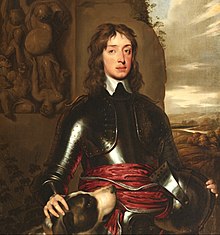The Earl of Northampton | |
|---|---|
 James Compton, 3rd Earl of Northampton | |
| Lord Lieutenant of Warwickshire | |
| In office 1660–1681 | |
| Constable of the Tower of London | |
| In office 1675–1679 | |
| Privy Councillor | |
| In office 1673–1679 | |
| Member of Parliament for Warwickshire | |
| In office November 1640 – September 1642 (excluded) | |
| Personal details | |
| Born | James Compton 19 August 1622 Compton Wynyates |
| Died | 15 December 1681 (aged 59) Castle Ashby House |
| Resting place | Compton Wynyates burial grounds |
| Nationality | English |
| Political party | Royalist |
| Spouse(s) | (1) Isabella Sackville (1647–1661) (2) Mary Noel (1663–his death) |
| Children | Alethea (1661–1678); George (1664–1727); Mary, (1669–1691); Spencer (1674–1743) [1] |
| Parent(s) | Spencer Compton, 2nd Earl of Northampton Mary Beaumont |
| Residence | Castle Ashby House |
| Alma mater | Queens' College, Cambridge |
| Occupation | Playwright, translator, landowner, soldier and Royalist politician |
| Military service | |
| Allegiance | |
| Rank | Colonel |
| Unit | Earl of Northampton's Regiment of Horse |
| Battles/wars | First English Civil War Edgehill; Hopton Heath; First Newbury; Cropredy Bridge; Islip Bridge; Naseby; Siege of Oxford Booth's Uprising |
James Compton, 3rd Earl of Northampton FRS (19 August 1622 – 15 December 1681), was an English peer, politician and author, who fought for the Royalists during the First English Civil War.
He succeeded his father Spencer Compton, 2nd Earl of Northampton when he was killed in March 1643 at the Battle of Hopton Heath. After the war ended in Royalist defeat in 1646, he spent the next 14 years living quietly on his estates, although he was arrested several times on suspicion of involvement in conspiracies to restore Charles II.
Following The Restoration in 1660, he was rewarded with appointments as Lord Lieutenant of Warwickshire and Constable of the Tower of London. While he attended the House of Lords on a regular basis, he played little role in active politics; his third son Spencer briefly became prime minister from 1742 to 1743. He died in December 1681.
Although known to have written a number of plays and translated others, the full extent of his output was only revealed when a cache of papers was discovered at the family home of Castle Ashby House in 1977. Based on this, it is suggested "his name should be added to the list of 17th century, or more particularly of Cavalier, playwrights".[2]
- ^ Burke & Burke 1848, p. 742.
- ^ Kelliher 1980, p. 158.